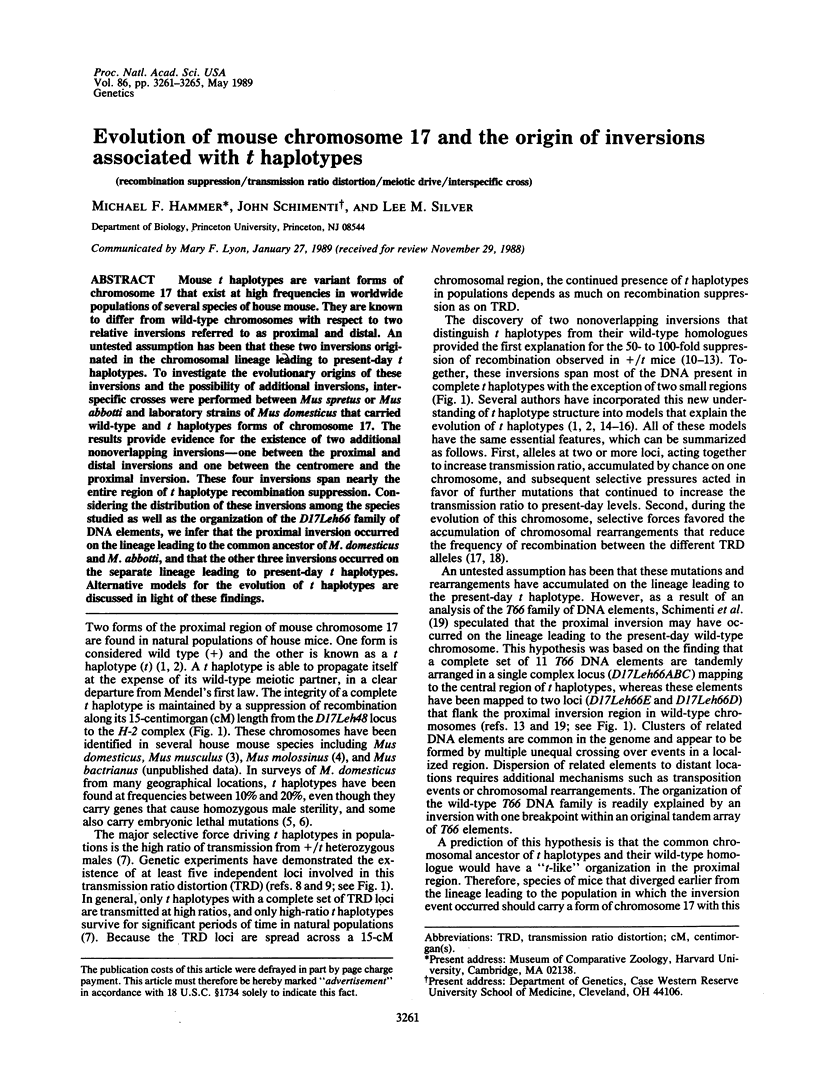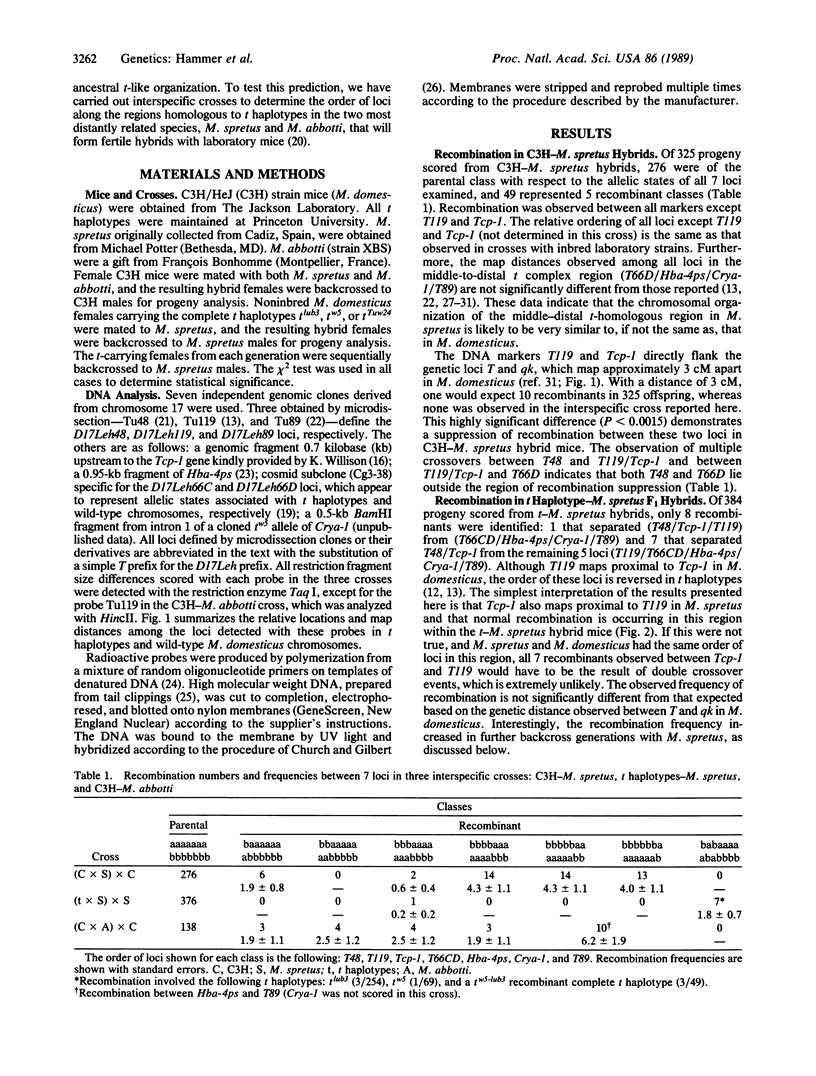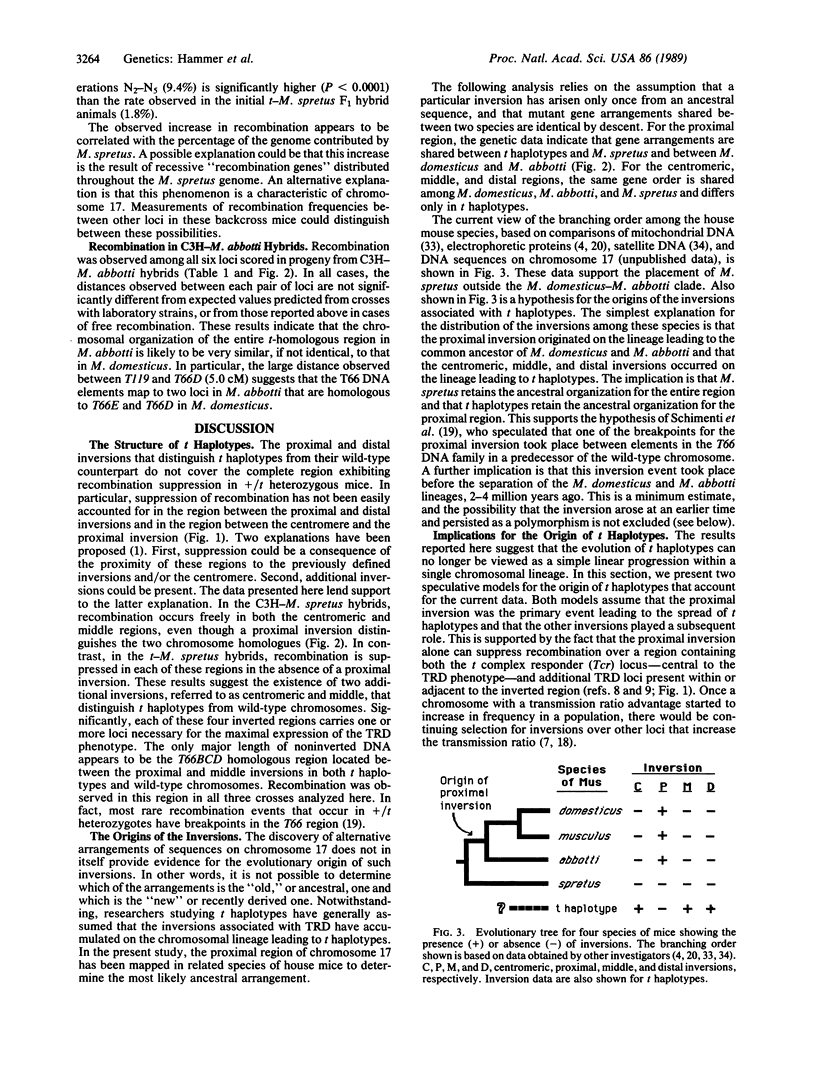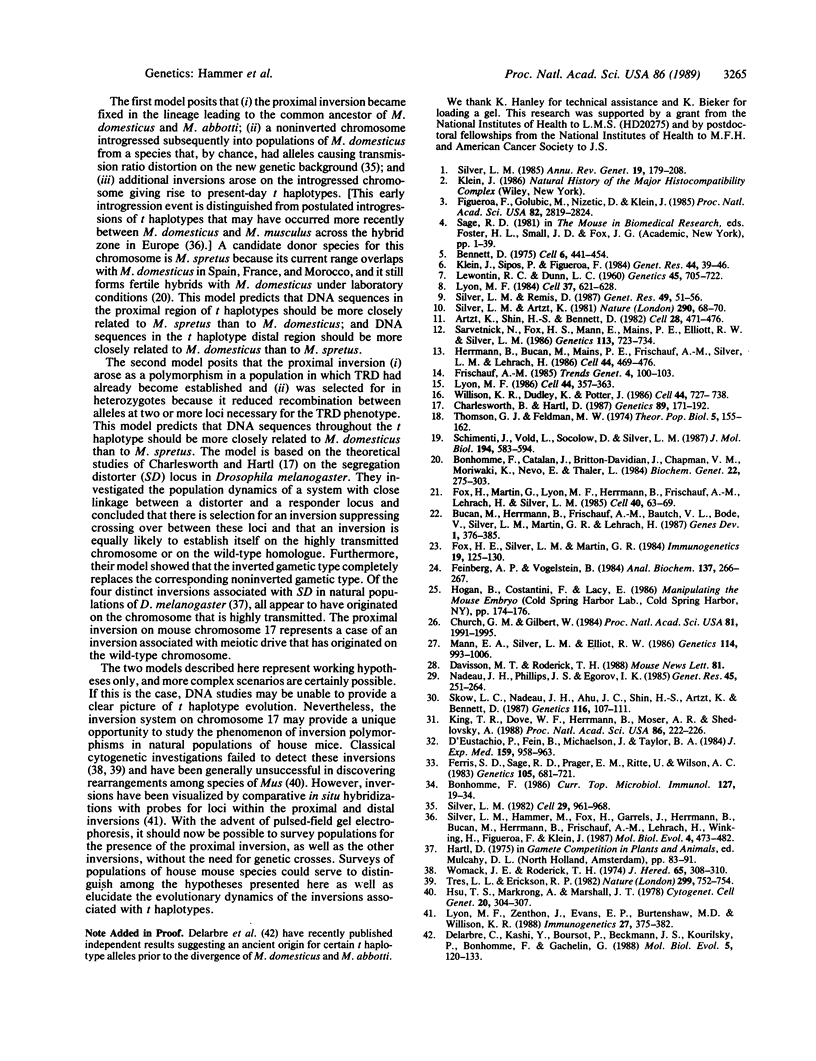Abstract
Mouse t haplotypes are variant forms of chromosome 17 that exist at high frequencies in worldwide populations of several species of house mouse. They are known to differ from wild-type chromosomes with respect to two relative inversions referred to as proximal and distal. An untested assumption has been that these two inversions originated in the chromosomal lineage leading to present-day t haplotypes. To investigate the evolutionary origins of these inversions and the possibility of additional inversions, interspecific crosses were performed between Mus spretus or Mus abbotti and laboratory strains of Mus domesticus that carried wild-type and t haplotypes forms of chromosome 17. The results provide evidence for the existence of two additional nonoverlapping inversions--one between the proximal and distal inversions and one between the centromere and the proximal inversion. These four inversions span nearly the entire region of t haplotype recombination suppression. Considering the distribution of these inversions among the species studied as well as the organization of the D17Leh66 family of DNA elements, we infer that the proximal inversion occurred on the lineage leading to the common ancestor of M. domesticus and M. abbotti, and that the other three inversions occurred on the separate lineage leading to present-day t haplotypes. Alternative models for the evolution of t haplotypes are discussed in light of these findings.
Full text
PDF




Selected References
These references are in PubMed. This may not be the complete list of references from this article.
- Artzt K., Shin H. S., Bennett D. Gene mapping within the T/t complex of the mouse. II. Anomalous position of the H-2 complex in t haplotypes. Cell. 1982 Mar;28(3):471–476. doi: 10.1016/0092-8674(82)90201-x. [DOI] [PubMed] [Google Scholar]
- Bonhomme F., Catalan J., Britton-Davidian J., Chapman V. M., Moriwaki K., Nevo E., Thaler L. Biochemical diversity and evolution in the genus Mus. Biochem Genet. 1984 Apr;22(3-4):275–303. doi: 10.1007/BF00484229. [DOI] [PubMed] [Google Scholar]
- Bonhomme F. Evolutionary relationships in the genus Mus. Curr Top Microbiol Immunol. 1986;127:19–34. doi: 10.1007/978-3-642-71304-0_3. [DOI] [PubMed] [Google Scholar]
- Búcan M., Herrmann B. G., Frischauf A. M., Bautch V. L., Bode V., Silver L. M., Martin G. R., Lehrach H. Deletion and duplication of DNA sequences is associated with the embryonic lethal phenotype of the t9 complementation group of the mouse t complex. Genes Dev. 1987 Jun;1(4):376–385. doi: 10.1101/gad.1.4.376. [DOI] [PubMed] [Google Scholar]
- Charlesworth B., Hartl D. L. Population Dynamics of the Segregation Distorter Polymorphism of DROSOPHILA MELANOGASTER. Genetics. 1978 May;89(1):171–192. doi: 10.1093/genetics/89.1.171. [DOI] [PMC free article] [PubMed] [Google Scholar]
- Church G. M., Gilbert W. Genomic sequencing. Proc Natl Acad Sci U S A. 1984 Apr;81(7):1991–1995. doi: 10.1073/pnas.81.7.1991. [DOI] [PMC free article] [PubMed] [Google Scholar]
- D'Eustachio P., Fein B., Michaelson J., Taylor B. A. The alpha-globin pseudogene on mouse chromosome 17 is closely linked to H-2. J Exp Med. 1984 Mar 1;159(3):958–963. doi: 10.1084/jem.159.3.958. [DOI] [PMC free article] [PubMed] [Google Scholar]
- Delarbre C., Kashi Y., Boursot P., Beckmann J. S., Kourilsky P., Bonhomme F., Gachelin G. Phylogenetic distribution in the genus Mus of t-complex-specific DNA and protein markers: inferences on the origin of t-haplotypes. Mol Biol Evol. 1988 Mar;5(2):120–133. doi: 10.1093/oxfordjournals.molbev.a040481. [DOI] [PubMed] [Google Scholar]
- Feinberg A. P., Vogelstein B. "A technique for radiolabeling DNA restriction endonuclease fragments to high specific activity". Addendum. Anal Biochem. 1984 Feb;137(1):266–267. doi: 10.1016/0003-2697(84)90381-6. [DOI] [PubMed] [Google Scholar]
- Ferris S. D., Sage R. D., Prager E. M., Ritte U., Wilson A. C. Mitochondrial DNA evolution in mice. Genetics. 1983 Nov;105(3):681–721. doi: 10.1093/genetics/105.3.681. [DOI] [PMC free article] [PubMed] [Google Scholar]
- Figueroa F., Golubić M., Nizetić D., Klein J. Evolution of mouse major histocompatibility complex genes borne by t chromosomes. Proc Natl Acad Sci U S A. 1985 May;82(9):2819–2823. doi: 10.1073/pnas.82.9.2819. [DOI] [PMC free article] [PubMed] [Google Scholar]
- Fox H. S., Martin G. R., Lyon M. F., Herrmann B., Frischauf A. M., Lehrach H., Silver L. M. Molecular probes define different regions of the mouse t complex. Cell. 1985 Jan;40(1):63–69. doi: 10.1016/0092-8674(85)90309-5. [DOI] [PubMed] [Google Scholar]
- Fox H. S., Silver L. M., Martin G. R. An alpha globin pseudogene is located within the mouse t complex. Immunogenetics. 1984;19(2):125–130. doi: 10.1007/BF00387855. [DOI] [PubMed] [Google Scholar]
- Herrmann B., Bućan M., Mains P. E., Frischauf A. M., Silver L. M., Lehrach H. Genetic analysis of the proximal portion of the mouse t complex: evidence for a second inversion within t haplotypes. Cell. 1986 Feb 14;44(3):469–476. doi: 10.1016/0092-8674(86)90468-x. [DOI] [PubMed] [Google Scholar]
- Hsu T. C., Markvong A., Marshall J. T. G-band patterns of six species of mice belonging to subgenus Mus. Cytogenet Cell Genet. 1978;20(1-6):304–307. doi: 10.1159/000130860. [DOI] [PubMed] [Google Scholar]
- King T. R., Dove W. F., Herrmann B., Moser A. R., Shedlovsky A. Mapping to molecular resolution in the T to H-2 region of the mouse genome with a nested set of meiotic recombinants. Proc Natl Acad Sci U S A. 1989 Jan;86(1):222–226. doi: 10.1073/pnas.86.1.222. [DOI] [PMC free article] [PubMed] [Google Scholar]
- Lewontin R C, Dunn L C. The Evolutionary Dynamics of a Polymorphism in the House Mouse. Genetics. 1960 Jun;45(6):705–722. doi: 10.1093/genetics/45.6.705. [DOI] [PMC free article] [PubMed] [Google Scholar]
- Lyon M. F. Male sterility of the mouse t-complex is due to homozygosity of the distorter genes. Cell. 1986 Jan 31;44(2):357–363. doi: 10.1016/0092-8674(86)90770-1. [DOI] [PubMed] [Google Scholar]
- Lyon M. F. Transmission ratio distortion in mouse t-haplotypes is due to multiple distorter genes acting on a responder locus. Cell. 1984 Jun;37(2):621–628. doi: 10.1016/0092-8674(84)90393-3. [DOI] [PubMed] [Google Scholar]
- Lyon M. F., Zenthon J., Evans E. P., Burtenshaw M. D., Willison K. R. Extent of the mouse t complex and its inversions shown by in situ hybridization. Immunogenetics. 1988;27(5):375–382. doi: 10.1007/BF00395134. [DOI] [PubMed] [Google Scholar]
- Mann E. A., Silver L. M., Elliott R. W. Genetic analysis of a mouse t complex locus that is homologous to a kidney cDNA clone. Genetics. 1986 Nov;114(3):993–1006. doi: 10.1093/genetics/114.3.993. [DOI] [PMC free article] [PubMed] [Google Scholar]
- Nadeau J. H., Phillips S. J., Egorov I. K. Recombination between the t6 complex and linked loci in the house mouse. Genet Res. 1985 Jun;45(3):251–264. doi: 10.1017/s0016672300022242. [DOI] [PubMed] [Google Scholar]
- Sarvetnick N., Fox H. S., Mann E., Mains P. E., Elliott R. W., Silver L. M. Nonhomologous pairing in mice heterozygous for a t haplotype can produce recombinant chromosomes with duplications and deletions. Genetics. 1986 Jul;113(3):723–734. doi: 10.1093/genetics/113.3.723. [DOI] [PMC free article] [PubMed] [Google Scholar]
- Schimenti J., Vold L., Socolow D., Silver L. M. An unstable family of large DNA elements in the center of the mouse t complex. J Mol Biol. 1987 Apr 20;194(4):583–594. doi: 10.1016/0022-2836(87)90235-x. [DOI] [PubMed] [Google Scholar]
- Silver L. M., Artzt K. Recombination suppression of mouse t-haplotypes due to chromatin mismatching. Nature. 1981 Mar 5;290(5801):68–70. doi: 10.1038/290068a0. [DOI] [PubMed] [Google Scholar]
- Silver L. M. Genomic analysis of the H-2 complex region associated with mouse t haplotypes. Cell. 1982 Jul;29(3):961–968. doi: 10.1016/0092-8674(82)90459-7. [DOI] [PubMed] [Google Scholar]
- Silver L. M., Hammer M., Fox H., Garrels J., Bucan M., Herrmann B., Frischauf A. M., Lehrach H., Winking H., Figueroa F. Molecular evidence for the rapid propagation of mouse t haplotypes from a single, recent, ancestral chromosome. Mol Biol Evol. 1987 Sep;4(5):473–482. doi: 10.1093/oxfordjournals.molbev.a040457. [DOI] [PubMed] [Google Scholar]
- Silver L. M. Mouse t haplotypes. Annu Rev Genet. 1985;19:179–208. doi: 10.1146/annurev.ge.19.120185.001143. [DOI] [PubMed] [Google Scholar]
- Silver L. M., Remis D. Five of the nine genetically defined regions of mouse t haplotypes are involved in transmission ratio distortion. Genet Res. 1987 Feb;49(1):51–56. doi: 10.1017/s0016672300026720. [DOI] [PubMed] [Google Scholar]
- Skow L. C., Nadeau J. N., Ahn J. C., Shin H. S., Artzt K., Bennett D. Polymorphism and linkage of the alpha A-crystallin gene in t-haplotypes of the mouse. Genetics. 1987 May;116(1):107–111. doi: 10.1093/genetics/116.1.107. [DOI] [PMC free article] [PubMed] [Google Scholar]
- Thomson G. J., Feldman M. W. Population genetics of modifiers of meiotic drive. II. Linkage modification in the segregation distortion system. Theor Popul Biol. 1974 Apr;5(2):155–162. doi: 10.1016/0040-5809(74)90038-0. [DOI] [PubMed] [Google Scholar]
- Tres L. L., Erickson R. P. Electron microscopy of t-allele synaptonemal complexes discloses no inversions. Nature. 1982 Oct 21;299(5885):752–754. doi: 10.1038/299752a0. [DOI] [PubMed] [Google Scholar]
- Willison K. R., Dudley K., Potter J. Molecular cloning and sequence analysis of a haploid expressed gene encoding t complex polypeptide 1. Cell. 1986 Mar 14;44(5):727–738. doi: 10.1016/0092-8674(86)90839-1. [DOI] [PubMed] [Google Scholar]
- Womack J. E., Roderick T. H. T-alleles in the mouse are probably not inversions. J Hered. 1974 Sep-Oct;65(5):308–310. doi: 10.1093/oxfordjournals.jhered.a108534. [DOI] [PubMed] [Google Scholar]


